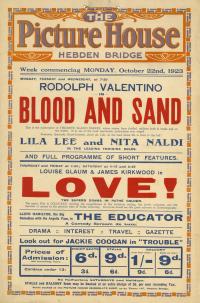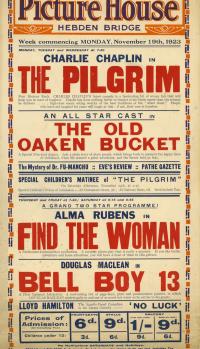
100 Years on Screen at Hebden Bridge Picture House
Hebden Bridge Picture House opened in 1921, and has been bringing the magic of the silver screen to the people of Hebden Bridge ever since. In this blog, Pennine Heritage volunteer Sue explores two programmes from October and November 1923, to find out what local people were watching 100 years ago.
The Hebden Bridge Picture House opened in 1921, and I have been looking at programmes for October/November 1923 – almost exactly 100 years ago. These programmes are digitised in the Pennine Horizons Digital Archive.

DFP00109 – The week of 22nd October 1923
From 22nd October 1923 a Rudolph Valentino film Blood and Sand was showing for 3 days, Monday to Wednesday, with just one showing at 7.30pm. There was also a ‘full programme of short features’, which would likely include a newsreel (Pathé news was producing films from 1910), in an era when it would still be a novelty to see the news rather than read about it.
On Thursday, Friday and with 2 screenings on Saturday was a film called LOVE starring Louise Glaum and James Kirkwood, described as a superb drama and in ‘Pathé colour’. I had no idea there were colour films in 1923, but a quick look at Wikipedia showed the first colour film was made in 1903. Colour films were few and far between by 1923, but they did exist. Often the entire film was coloured by hand.
Included in this programme was a comedy The Educator. It all sounds quite good value as tickets varied from 3d (less than 1.5p) for a child in the front seats to 1/- (5p) for the front row of the balcony.
Oh – and don’t forget that that all these films would have been silent – probably accompanied by live music.

DFP00114 – The week of 19th November, 1923.
From 19th November, Charlie Chaplin was starring in The Pilgrim and the programme included The Old Oaken Bucket (a five-part drama – ‘a plain story of plain people,’ maybe an early soap opera?).
Once again, there was one programme for Monday to Wednesday and another for Thursday to Sunday. The second half of the week had a double bill – a mystery called Find the Woman, plus ‘Bell Boy 13’ which is described as ‘a roof-raising riot of page-boys, plots and parsimonious parents in which DOUGLAS MACLEAN canters gaily in and out of as much hot water as he carries to his guests’
It seems that the Picture House used to be closed on a Sunday, which was usual for most businesses in 1923, with many people going to church or chapel.
For an extra 3d it was possible to book balcony or stalls seats – bookings were made by calling into the Picture House Chocolate Shop or ringing them on 147 Hebden Bridge!
With a telephone booking service and colour films, the picture house was more sophisticated than I had expected it to be 100 years ago.
Surprisingly little has changed over the 100 years.Today we can book online rather than in the Chocolate Shop, and the Picture House is open 7 days a week – but there are still changes of programme through the week, matinees at weekends and chocolate on sale in the foyer.A visitor from 100 years ago may be surprised by the ‘talkies’ and the quality of colour (also the lack of anyone smoking in the cinema, I remember when every seat had an ashtray on the back) – but a trip to the pictures would probably be comfortingly familiar.